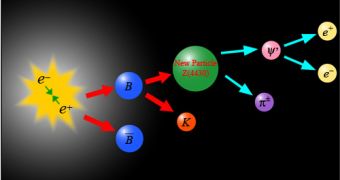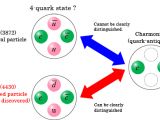The newly discovered particle is part of the meson class of particles, has a non-zero electric charge, and is composed of four quarks. The announcement of the discovery of the new particle was made by researchers at the High Energy Accelerator Research Organization (KEK) in Tsukuba, Japan, and named the exotic particle Z(4430)*2.
Mesons are a class of particles, formed of quarks, meaning they are part of the hadron family. They carry strong interaction forces, meaning they are a type of bosons. They were first predicted as a carrier of the forces that bind protons and neutrons together. Though the first ever discovered meson was a muon particle, it seemed that it carried only a weak attraction to nuclear matter, and was later classified as a lepton, the family of particles out of which the electrons are part of. The first true meson discovered was the pion.
The particle was discovered through the collision of two leptons, an electron and its anti-particle, the positron. The interaction between the two particles, results in two B-mesons, meaning a meson that contains a bottom quark. While investigating the decay of the B-meson, in a data sample containing about 660 million pairs of B and anti-B mesons, the Belle team, observed the decay of about 120 B-mesons, into Z(4430), the newly discovered particle, and a K-meson. Then the researchers observed the instant decay of Z(4430) into a "Psi-prime" and a pi-meson. The data provided by the measurements, suggested that the particle has the electric charge equal to that of the electron, and a mass of about 4.7 times that of the proton.
Though the particle does not fit in the usual scheme of the "mesons", which are a combination of three quarks and an anti-quark held together by strong forces, in the last year the team at Belle has discovered multiple such peculiar particles, including X(3872), Y(3940) and others. They usually have a mass between 4 and 4.5 time the mass of the proton, and decay instantly into "J/psi" or "Psi-prime" particles and pi-mesons. J/psi and Psi-prime particles, are charmonium mesons, meaning they are a combination of charm quarks and its anti-particle.
The decay properties and the masses of these sub-atomic particles cannot be explained by physics so far, since there is no theory regarding them, but physicists around the world have proposed a number of explanations, including the possibility that some of these particles are actually made out of four quarks, in a combination of two quarks and their anti particles. However, since they are electrically neutral, they cannot be distinguished from charmonium mesons, so it was proposed that they are actually an excited state of the respective particle.
Nevertheless, the Z(4430) has a non-zero electric charge, and can be distinguished from the charmonium mesons, therefore it must have a charm quark, an anti-charm quark and at least two more quarks, thus it does not fit in the known mesons.
Single quarks do not exist freely in nature, and cannot be isolated, they are only confined in composite particles such as mesons. The new discovery may give better insight in the understanding of how quarks behave in composite particles and the formation of matter in QCD (Quantum Chromo Dynamics).

 14 DAY TRIAL //
14 DAY TRIAL // 
